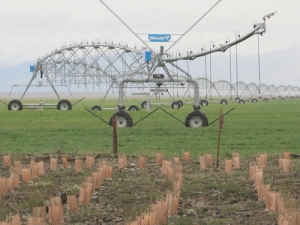Wired for Science: Understanding the feeding habits of mealybug
Fussy children might be frustrating, but fussy mealybugs could help protect the New Zealand wine industry from grapevine leafroll-associated virus 3.
 The Ngai Tāhu Farming project shows there are "means and ways" to restore natural biodiversity into a dairy farming environment.
The Ngai Tāhu Farming project shows there are "means and ways" to restore natural biodiversity into a dairy farming environment.
A new study is showing dairy and conservation sites can co-exist, and its findings are contributing to an ongoing project restoring natural biodiversity into a dairy farming environment.
'Persistence of biodiversity in a dryland remnant within an intensified dairy farm landscape', looks at Bankside Scientific Reserve, a small (2.6 ha) remnant in Canterbury surrounded by dairy paddocks.
It still has valuable communities of native species, despite being impacted by nitrate and phosphate encroachment, and habitat fragmentation.
It concludes "it does not appear to be an intractable management issue for the interface between agricultural systems and conservation sites within a dairy landscape mosaic".
One of the study's authors, Professor of Ecology, Nick Dickinson, and other Lincoln scientists have been tasked by Ngāi Tahu Farming and Manawhenua from Tuahuriri Marae, to turn the little triangles of land which irrigators in paddocks cannot reach into an oasis for native plants and animals on Ngāi Tahu's Eyrewell dairy farm.
Professor Dickinson says the study shows there are "means and ways" to restore natural biodiversity into a dairy farming environment, and the Ngai Tāhu Farming project was an example, covering 150ha on 17 reserves, with a similar additional amount of native species being planted on paddock borders and under irrigators.
These create conditions for more than 65 species of plants to regenerate, and also provide corridors for insects and birds between the reserves.
The research hinges on finding the benefits to the farmer of doing this, to encourage more native planting, he says.
The National Wild Goat Hunting Competition has removed 33,418 wild goats over the past three years.
New Zealand needs a new healthcare model to address rising rates of obesity in rural communities, with the current system leaving many patients unable to access effective treatment or long-term support, warn GPs.
Southland farmers are being urged to put safety first, following a spike in tip offs about risky handling of wind-damaged trees
Third-generation Ashburton dairy farmers TJ and Mark Stewart are no strangers to adapting and evolving.
When American retail giant Cosco came to audit Open Country Dairy’s new butter plant at the Waharoa site and give the green light to supply their American stores, they allowed themselves a week for the exercise.
Fonterra chair Peter McBride says the divestment of Mainland Group is their last significant asset sale and signals the end of structural changes.
President Donald Trump’s decision to impose tariffs on imports into the US is doing good things for global trade, according…
Seen a giant cheese roll rolling along Southland’s roads?